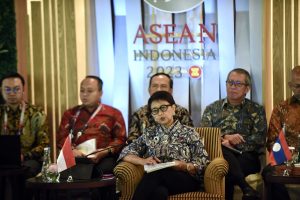Tomorrow, the Association of Southeast Asian Nations (ASEAN) will begin a three-day run of summits and meetings against a backdrop of intensifying frictions in the South China Sea.
The disputes, which pit China’s expansive “nine-dash line” maritime claim against rival claims from four Southeast Asian claimants – Vietnam, Malaysia, the Philippines, and Brunei – have been a perennial agenda item for the 10-nation bloc. After two years in which other pressing regional challenges – in particular, the nationwide conflict in Myanmar – have eclipsed the disputes, a recent string of aggressive “grey zone” activities by the Chinese Coast Guard in waters claimed by Vietnam and the Philippines has put the maritime disputes once again at the top of the bloc’s agenda.
On August 5, a China Coast Guard vessel blocked and shot a water cannon at a Philippine navy-chartered supply boat in the vicinity of Second Thomas Shoal in the Spratly Islands, forcing it to abandon its attempts to resupply the Sierra Madre, a decrepit World War II-era ship that was intentionally grounded in the shoal’s shallow waters in 1999. This came after a similar incident near Second Thomas Shoal in February involving a Chinese Coast Guard vessel, this time involving the use of a military-grade laser.
The past six months have also seen an increase in Chinese incursions into waters also claimed by Vietnam. Vietnamese fishermen claimed that a Chinese vessel attacked their fishing boat with a high-pressure water cannon in the South China Sea on August 28, injuring two of them.
To cap off a year of confrontation, China’s Ministry of Natural Resources last week released the latest iteration of its “standard map,” which depicted what appeared to be an expanded version of the “nine-dash line” claim.
The release of the map prompted angry, if restrained, responses from the four Southeast Asian claimants, in addition to India and Taiwan. Malaysia stated that it “does not recognize China’s claims in the South China Sea” while Vietnam said that it “resolutely rejects any claims in the East Sea by China that are based on the dashed line.” The Philippines called on China “to act responsibly and abide by its obligations” under international maritime law.
Even Brunei, which rarely speaks publicly about its South China Sea claims, issued a statement on Saturday in which it reaffirmed its “commitment to the maintenance of peace, stability and security in the South China Sea.” It stated that “maritime entitlements of mainland and insular territory, and other maritime features are governed exclusively by international law,” in particular, the U.N. Convention on the Law of the Sea (UNCLOS), and that “all countries concerned need to promote a calm, peaceful, and conducive environment, building confidence and enhancing mutual trust in the region.”
The fact that normally reticent Brunei has seen the need to speak out about the situation in disputed waters demonstrates the pressure that ASEAN is under to address the disputes. The current approach has clearly not produced the desired results.
ASEAN’s approach to the disputes is based on the Declaration on the Conduct of Parties in the South China Sea, which the bloc signed with China in 2002. This included a call for the negotiation of a Code of Conduct (COC) for the South China Sea to guide the resolution of maritime and territorial disputes and committed the parties to exercise “self-restraint in the conduct of activities that would complicate or escalate disputes and affect peace and stability.”
However, this process has failed to resolve any of the underlying disputes. The COC negotiations have now dragged on for more than two decades, during which time China’s economic heft and military power have increased by an order of magnitude and Beijing has long ceased to exercise “self-restraint,” asserting its control over disputed waters on rival claimants’ doorstep and militarizing a number of features in the Spratly Islands.
As this year’s chair of ASEAN, Indonesia has approved a series of guidelines aimed at the acceleration of the COC negotiations, with the aim of finalizing the code within three years. Rolliansyah Soemira, the director for ASEAN political and security cooperation at Indonesia’s Foreign Affairs Ministry said on Saturday that the guidelines are set to be approved at the ASEAN-China Summit on September 6.
While ASEAN remains committed to finalizing the COC, which has seen Southeast Asian claimants put off negotiating the delimitation of their own overlapping claims in the South China Sea, recent events raise questions about whether the bloc should shift course.
As Evan Laksmana of the International Institute for Strategic Studies wrote last week, “ASEAN’s focus on keeping the Code of Conduct process alive represents the performance of progress, given that the strategic rationale for the talks vis-à-vis China has evaporated.”
Whether the upcoming summits will see any progress on this front is unlikely, given the bloc’s need for consensus from states like Laos and Cambodia over whom China has considerable influence, and which have little direct stake in the South China Sea. But as Laksmana argued, even if ASEAN and China finalize the code by 2026, claimants should recognize the limits of the COC process, which “will not resolve any underlying disputes,” a long-term process that can only take place under the terms of UNCLOS. “Thus,” he concluded, “there is no reason for ASEAN member states to delay these efforts until after a Code of Conduct is agreed.”
Indeed, the mutual delineation of rival claims would put Southeast Asian claimants in a much better position to push back against China and to negotiate with it, if necessary, from a position of greater strength.

































